Basics of Quadratic Equations | Mathematics (Maths) Class 11 - Commerce PDF Download
Quadratic Equation
- A quadratic equation is a type of algebraic expression that involves a variable raised to the second degree. It is commonly written in the form: ax² + bx + c = 0.
- The word quadratic comes from the Latin word quadratus, which means square. This relates to the fact that the variable x is squared in the equation.
- In simpler terms, a quadratic equation is referred to as an equation of degree 2.
- Quadratic equations can be found in many different situations and fields.
- For instance, when a rocket is launched, its trajectory or path can be described using a quadratic equation.
- These equations have a wide range of uses in areas like physics, engineering, and astronomy.
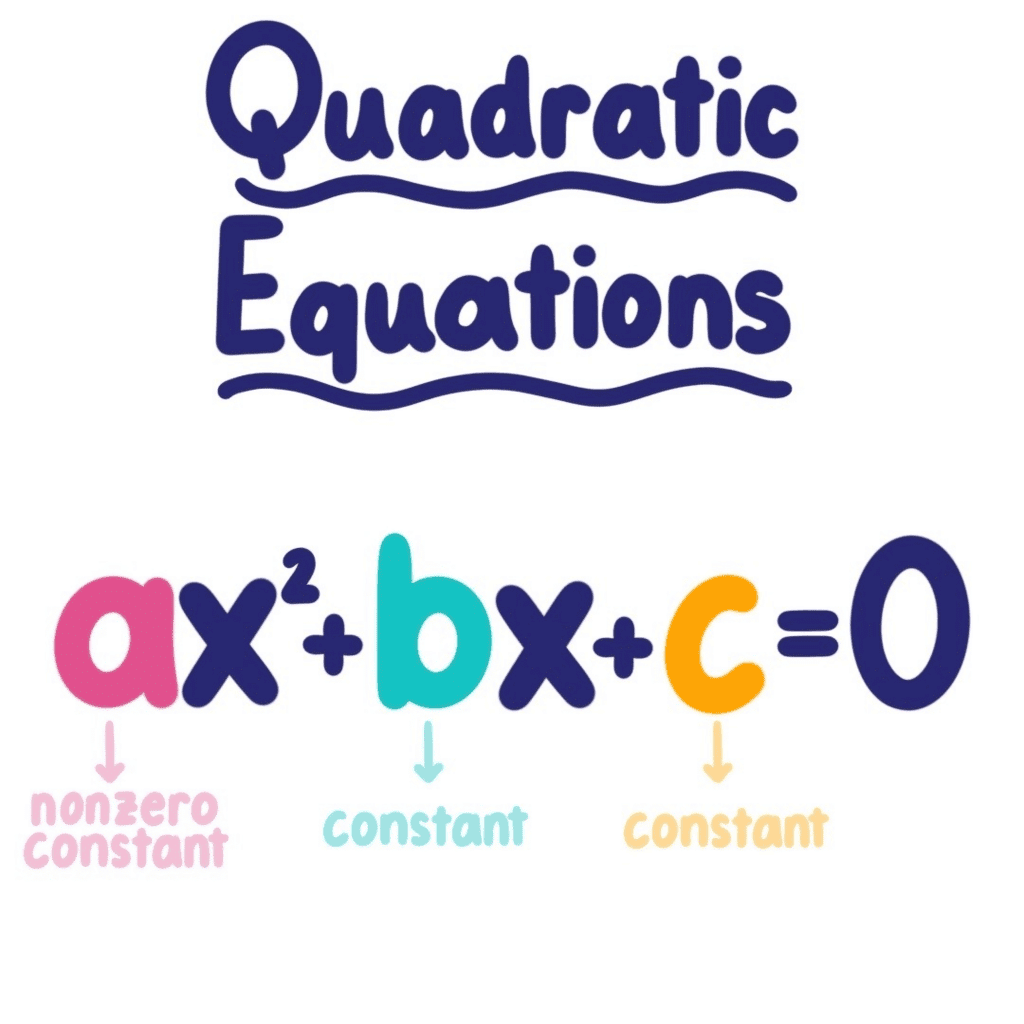 Quadratic equations have maximum of two solutions, which can be real or complex numbers. These two solutions (values of x) are also called the roots of the quadratic equations and are designated as (α, β). We shall learn more about the roots of a quadratic equation in the below content.
Quadratic equations have maximum of two solutions, which can be real or complex numbers. These two solutions (values of x) are also called the roots of the quadratic equations and are designated as (α, β). We shall learn more about the roots of a quadratic equation in the below content.What is Quadratic Equation?
- A quadratic equation is a type of algebraic equation that involves the variable x and is of the second degree.
- In its standard form, a quadratic equation is expressed as ax² + bx + c = 0, where:
- a and b are the coefficients (numbers that multiply the variables),
- x is the variable itself,
- c is the constant term (a number without a variable).
- For an equation to qualify as a quadratic equation, it is essential that the coefficient of x² (the first term) is a non-zero value. This means that a must not equal zero (a ≠ 0).
- When writing a quadratic equation in standard form, the terms are arranged in a specific order:
- First, the x² term appears,
- Next, the x term is listed,
- Finally, the constant term c is placed at the end.
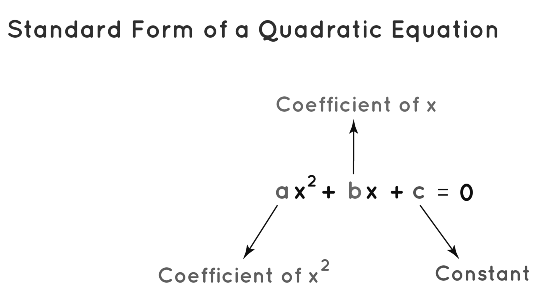
Further, in real math problems the quadratic equations are presented in different forms: (x - 1)(x + 2) = 0, -x2 = -3x + 1, 5x(x + 3) = 12x, x3 = x(x2 + x - 3). All of these equations need to be transformed into standard form of the quadratic equation before performing further operations.
Roots of a Quadratic Equation
The roots of a quadratic equation are the two values of x, which are obtained by solving the quadratic equation. These roots of the quadratic equation are also called the zeros of the equation. For example, the roots of the equation x2 - 3x - 4 = 0 are x = -1 and x = 4 because each of them satisfies the equation. i.e.,
- At x = -1, (-1)2 - 3(-1) - 4 = 1 + 3 - 4 = 0
- At x = 4, (4)2 - 3(4) - 4 = 16 - 12 - 4 = 0
There are various methods to find the roots of a quadratic equation. The usage of the quadratic formula is one of them.
Quadratic Formula
Quadratic formula is the simplest way to find the roots of a quadratic equation. There are certain quadratic equations that cannot be easily factorized, and here we can conveniently use this quadratic formula to find the roots in the quickest possible way. The two roots in the quadratic formula are presented as a single expression. The positive sign and the negative sign can be alternatively used to obtain the two distinct roots of the equation.
Quadratic Formula: The roots of a quadratic equation ax2 + bx + c = 0 are given by x = [-b ± √(b2 - 4ac)]/2a.
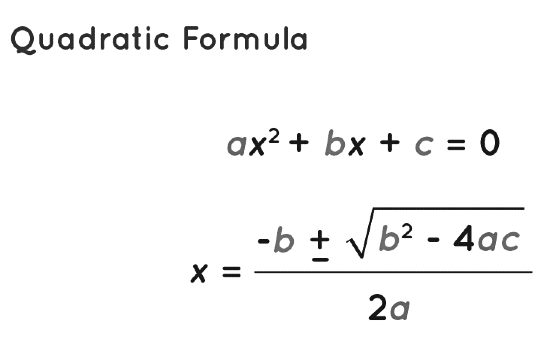
This formula is also known as the Sridharacharya formula.
Example: Let us find the roots of the same equation that was mentioned in the earlier section x2 - 3x - 4 = 0 using the quadratic formula.
a = 1, b = -3, and c = -4.
x = [-b ± √(b2 - 4ac)]/2a
= [-(-3) ± √((-3)2 - 4(1)(-4))]/2(1)
= [3 ± √25] / 2
= [3 ± 5] / 2
= (3 + 5)/2 or (3 - 5)/2
= 8/2 or -2/2
= 4 or -1 are the roots.
Proof of Quadratic Formula
Consider an arbitrary quadratic equation: ax2 + bx + c = 0, a ≠ 0
To determine the roots of this equation, we proceed as follows:
ax2 + bx = -c ⇒ x2 + bx/a = -c/a
Now, we express the left-hand side as a perfect square, by introducing a new term (b/2a)2 on both sides:
x2+ bx/a + (b/2a)2 = -c/a + (b/2a)2
The left-hand side is now a perfect square:
(x + b/2a)2 = -c/a + b2/4a2 ⇒ (x + b/2a)2 = (b2 - 4ac)/4a2
This is good for us, because now we can take square roots to obtain:
x + b/2a = ±√(b2 - 4ac)/2a
x = (-b ± √(b2 - 4ac))/2a
Thus, by completing the squares, we were able to isolate x and obtain the two roots of the equation.
Nature of Roots of the Quadratic Equation
The roots of a quadratic equation are usually represented to by the symbols alpha (α), and beta (β). Here we shall learn more about how to find the nature of roots of a quadratic equation without actually finding the roots of the equation.
The nature of roots of a quadratic equation can be found without actually finding the roots (α, β) of the equation. This is possible by taking the discriminant value, which is part of the formula to solve the quadratic equation. The value b2 - 4ac is called the discriminant of a quadratic equation and is designated as 'D'. Based on the discriminant value the nature of the roots of the quadratic equation can be predicted.
Discriminant: D = b2 - 4ac
D > 0, the roots are real and distinct
D = 0, the roots are real and equal.
D < 0, the roots do not exist or the roots are imaginary.
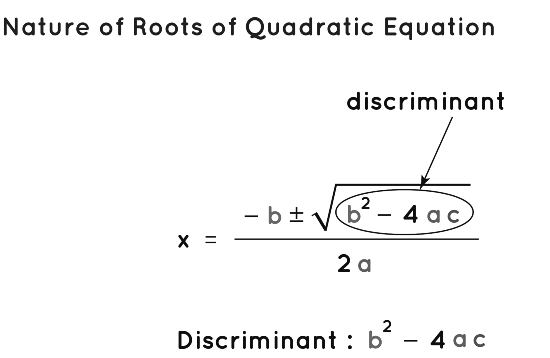
Now, check out the formulas to find the sum and the product of the roots of the equation.
Sum and Product of Roots of Quadratic Equation
The coefficient of x2, x term, and the constant term of the quadratic equation ax2 + bx + c = 0 are useful in determining the sum and product of the roots of the quadratic equation. The sum and product of the roots of a quadratic equation can be directly calculated from the equation, without actually finding the roots of the quadratic equation. For a quadratic equation ax2 + bx + c = 0, the sum and product of the roots are as follows.
- Sum of the Roots: α + β = -b/a = - Coefficient of x/ Coefficient of x2
- Product of the Roots: αβ = c/a = Constant term/ Coefficient of x2
Writing Quadratic Equations Using Roots
The quadratic equation can also be formed for the given roots of the equation. If α, β, are the roots of the quadratic equation, then the quadratic equation is as follows.
x2 - (α + β)x + αβ = 0
Example: What is the quadratic equation whose roots are 4 and -1?
Solution: It is given that α = 4 and β = -1. The corresponding quadratic equation is found by:
x2 - (α + β)x + αβ = 0
x2 - (α + β)x + αβ = 0
x2 - (4 - 1)x + (4)(-1) = 0
x2 - 3x - 4 = 0
Formulas Related to Quadratic Equations
The following list of important formulas is helpful to solve quadratic equations.
- The quadratic equation in its standard form is ax2 + bx + c = 0
- The discriminant of the quadratic equation is D = b2- 4ac
- For D > 0 the roots are real and distinct.
- For D = 0 the roots are real and equal.
- For D < 0 the real roots do not exist, or the roots are imaginary.
- The formula to find the roots of the quadratic equation is x = [-b ± √(b2 - 4ac)]/2a.
- The sum of the roots of a quadratic equation is α + β = -b/a.
- The product of the Root of the quadratic equation is αβ = c/a.
- The quadratic equation whose roots are α, β, is x2 - (α + β)x + αβ = 0.
- The condition for the quadratic equations a1x2 + b1x + c1 = 0, and a2x2 + b2x + c2 = 0 having the same roots is (a1b2 - a2b1) (b1c2 - b2c1) = (a2c1 - a1c2)2.
- When a > 0, the quadratic expression f(x) = ax2 + bx + c has a minimum value at x = -b/2a.
- When a < 0, the quadratic expression f(x) = ax2 + bx + c has a maximum value at x = -b/2a.
- The domain of any quadratic function is the set of all real numbers.
Methods to Solve Quadratic Equations
A quadratic equation can be solved to obtain two values of x or the two roots of the equation. There are four different methods to find the roots of the quadratic equation. The four methods of solving the quadratic equations are as follows.
- Factorizing of Quadratic Equation
- Using quadratic formula (which we have seen already)
- Method of Completing the Square
- Graphing Method to Find the Roots
Solving Quadratic Equations by Factorization
Factorization of quadratic equation follows a sequence of steps. For a general form of the quadratic equation ax2 + bx + c = 0, we need to first split the middle term into two terms, such that the product of the terms is equal to the constant term. Further, we can take the common terms from the available term, to finally obtain the required factors as follows:
- x2 + (a + b)x + ab = 0
- x2 + ax + bx + ab = 0
- x(x + a) + b(x + a)
- (x + a)(x + b) = 0
Here is an example to understand the factorization process.
- x2 + 5x + 6 = 0
- x2 + 2x + 3x + 6 = 0
- x(x + 2) + 3(x + 2) = 0
- (x + 2)(x + 3) = 0
Thus the two obtained factors of the quadratic equation are (x + 2) and (x + 3). To find its roots, just set each factor to zero and solve for x. i.e., x + 2 = 0 and x + 3 = 0 which gives x = -2 and x = -3. Thus, x = -2 and x = -3 are the roots of x2 + 5x + 6 = 0.
Further, there is another important method of solving a quadratic equation. The method of completing the square for a quadratic equation is also useful to find the roots of the equation.
Method of Completing the Square
The method of completing the square in a quadratic equation is to algebraically square and simplify, to obtain the required roots of the equation. Consider a quadratic equation ax2 + bx + c = 0, a ≠ 0. To determine the roots of this equation, we simplify it as follows:
- ax2 + bx + c = 0
- ax2 + bx = -c
- x2 + bx/a = -c/a
Now, we express the left-hand side as a perfect square, by introducing a new term (b/2a)2 on both sides:
- x2 + bx/a + (b/2a)2 = -c/a + (b/2a)2
- (x + b/2a)2 = -c/a + b2/4a2
- (x + b/2a)2 = (b2 - 4ac)/4a2
- x + b/2a = +√(b2- 4ac)/2a
- x = - b/2a +√(b2- 4ac)/2a
- x = [-b ± √(b2 - 4ac)]/2a
Here the '+' sign gives one root and the '-' sign gives another root of the quadratic equation. Generally, this detailed method is avoided, and only the quadratic formula is used to obtain the required roots.
Graphing a Quadratic Equation
The graph of the quadratic equation ax2 + bx + c = 0 can be obtained by representing the quadratic equation as a function y = ax2 + bx + c. Further by solving and substituting values for x, we can obtain values of y, we can obtain numerous points. These points can be presented in the coordinate axis to obtain a parabola-shaped graph for the quadratic equation.

The point(s) where the graph cuts the horizontal x-axis (typically the x-intercepts) is the solution of the quadratic equation. These points can also be algebraically obtained by equalizing the y value to 0 in the function y = ax2 + bx + c and solving for x.
Quadratic Equations Having Common Roots
Consider two quadratic equations having common roots a1x2 + b1x + c1 = 0, and a2x2 + b2x + c2 = 0. Let us solve these two equations to find the conditions for which these equations have a common root. The two equations are solved for x2 and x respectively.
(x2)(b1c2 - b2c1) = (-x)/(a1c2 - a2c1) = 1/(a1b2 - a2b1)
x2 = (b1c2 - b2c1) / (a1b2 - a2b1)
x = (a2c1 - a1c2) / (a1b2 - a2b1)
Hence, by simplifying the above two expressions we have the following condition for the two equations having the common root.
(a1b2 - a2b1) (b1c2 - b2c1) = (a2c1 - a1c2)2
Maximum and Minimum Value of Quadratic Expression
The maximum and minimum values for the quadratic function F(x) = ax2 + bx + c can be observed in the below graphs. For positive values of a (a > 0), the quadratic expression has a minimum value at x = -b/2a, and for negative value of a (a < 0), the quadratic expression has a maximum value at x = -b/2a. x = -b/2a is the x-coordinate of the vertex of the parabola.
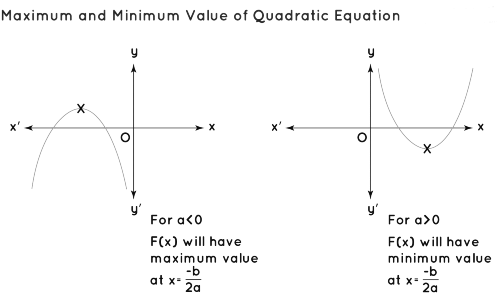
The maximum and minimum values of the quadratic expressions are of further help to find the range of the quadratic expression: The range of the quadratic expressions also depends on the value of a. For positive values of a( a > 0), the range is [ F(-b/2a), ∞), and for negative values of a ( a < 0), the range is (-∞, F(-b/2a)].
- For a > 0, Range: [ f(-b/2a), ∞)
- For a < 0, Range: (-∞, f(-b/2a)]
Note that the domain of a quadratic function is the set of all real numbers, i.e., (-∞, ∞).
Tips and Tricks on Quadratic Equation:
Some of the below-given tips and tricks on quadratic equations are helpful to more easily solve quadratic equations.
- The quadratic equations are generally solved through factorization. But in instances when it cannot be solved by factorization, the quadratic formula is used.
- The roots of a quadratic equation are also called the zeroes of the equation.
- For quadratic equations having negative discriminant values, the roots are represented by complex numbers.
- The sum and product of the roots of a quadratic equation can be used to find higher algebraic expressions involving these roots.
|
80 videos|315 docs|99 tests
|
FAQs on Basics of Quadratic Equations - Mathematics (Maths) Class 11 - Commerce
| 1. What is a quadratic equation and how can it be identified? |  |
| 2. How can quadratic equations be solved using square roots? |  |
| 3. What is the Zero Product Property and how is it used in solving factored quadratic equations? |  |
| 4. How do you solve factorable quadratic equations? |  |
| 5. What is the quadratic formula and when should it be used? |  |

















